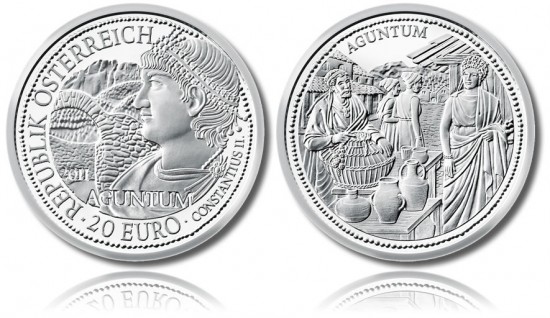Austrian 2011 Aguntum Silver Coin, Fourth in Rome on the Danube Series
August 18, 2011 by Darrin Lee Unser · Leave a Comment
The Austrian Mint’s popular "Rome on the Danube" series is continued with the pending September 7, 2011 release of the fourth coin in the program — the 2011 20€ Aguntum Silver Coin.

Austrian 2011 Aguntum Silver Coin, the fourth release in Rome on the Danube series
Both the obverse and reverse of the Aguntum silver coin feature imagery emblematic of the town located in present-day Austria. It served as an important trade center of the Roman Empire two millennia ago. Aguntum was established as early as 30 B.C., and was given the status of municipium by Emperor Claudius sometime in the next century.
It was in the reign of Emperor Constantius II (337-361) that Aguntum reached its height of power in the region. During that time, natural resources of the area, like iron, copper, zinc, gold and timber, were collected and processed by local craftsmen and merchants for export to other Roman towns. Combined along with another important staple, cheese, these products insured a thriving center of commerce despite the fact that no military post was established within the town’s boundaries.
However, the lack of a military presence spelled a relatively quick demise when invaders from the north attacked the region. Today, some of Aguntum’s ruins are still preserved in a museum.
Shown on the obverse of the 2011 20€ Aguntum Silver Coin is the image of Emperor Constantius II. His portrait is joined by a depiction of the remnants of a gate from the artisan quarter of Aguntum. Inscriptions include "Republik Oesterreich," "2011," "Constantius II," "20 Euro" and "Aguntum." It was designed by Austrian Mint engraver Herbert Waehner.
The silver coin reverse also includes the inscription of "Aguntum." Designed by Helmut Andexlinger, it features a scene showcasing the city as a center of trade, with both merchant and customers interacting.
The 20 Euro coin is struck from .900 fine silver to proof quality and contains a total of 18 grams of the precious metal. The 34mm encapsulated coin will ship with a numbered certificate of authenticity.
This strike serves as the fourth of six coins to be released by the Austrian Mint as part of its "Rome on the Danube" series. Other strikes in the series include coins depicting Virunum,Vindobona (Vienna), Carnuntum, Lauriacum (Lorch/Enns) and Brigantium (Bregenz).
About the Austrian Mint
The Austrian Mint (http://austrian-mint.at/) is located in Vienna and is the official minting authority for Austria with a history of over 800 years.
All Austrian Euro and Cent coins are struck at this facility no matter if they are intended for commerce or numismatic purposes. In its past, the Austrian Mint was responsible for striking other coins of Austria such as Schillings, Groschens, Crowns, Guilders and Ducats.
The Mint is located in the Biedermeier building of Vienna erected under Emperor Ferdinand I from 1835 to 1837.
![[Most Recent Quotes from www.kitco.com]](http://www.kitconet.com/images/quotes_2a.gif)




